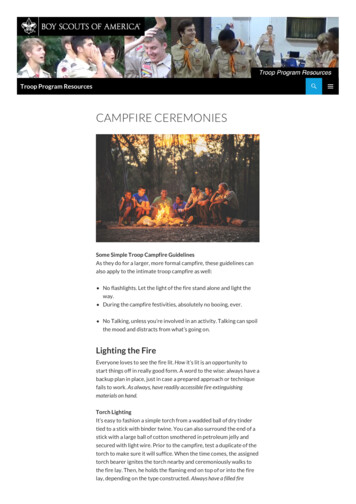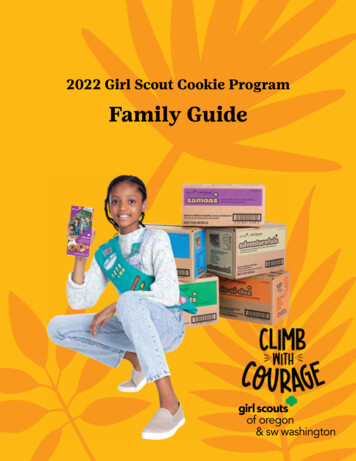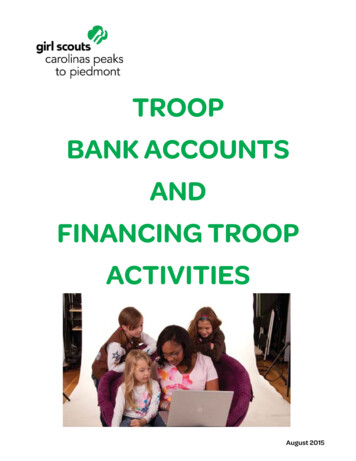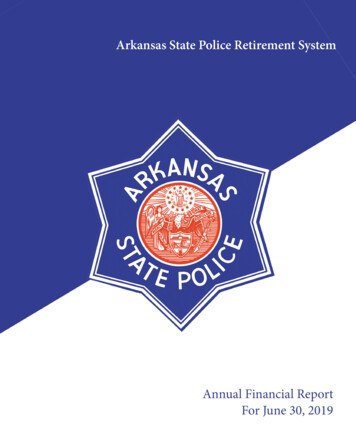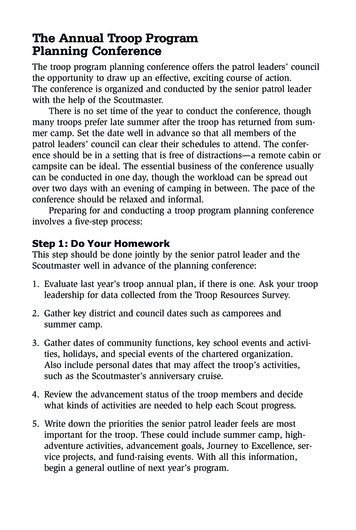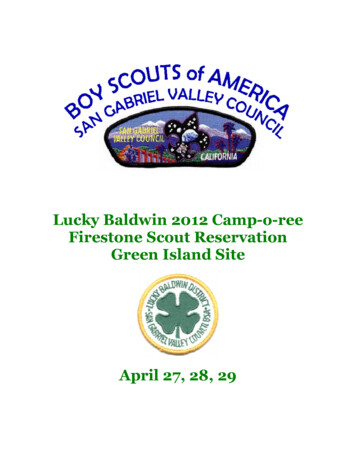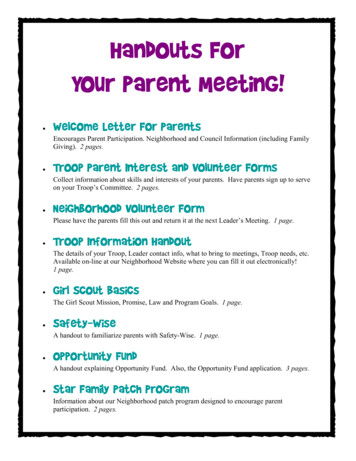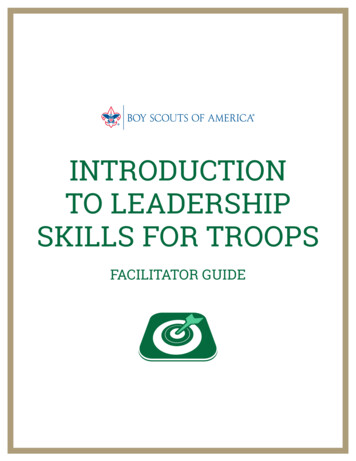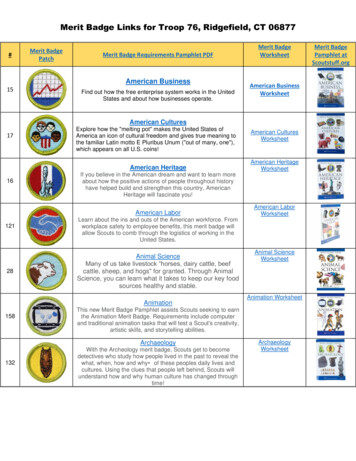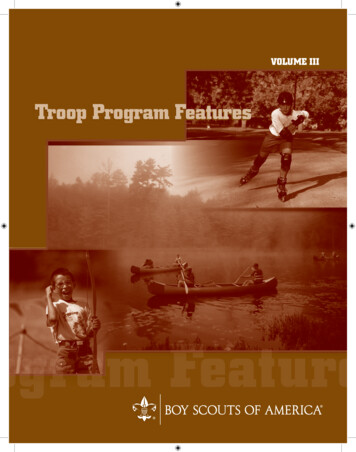
Transcription
VOLUME IIITroop Program Features
Troop Program FeaturesA Guide to Troop Program PlanningVolume IVolume IIVolume al AwarenessEmergency PreparednessEngineeringEnvironmentFirst AidFishingForestryHealth CareHigh enteeringPhysical FitnessPioneeringPublic ServiceSafetyScienceShootingSpecial CookingSportsTrackingWilderness SurvivalWildlife ManagementWinter CampingSKU 33112Boy Scouts of America1325 West Walnut Hill LaneP.O. Box 152079Irving, TX 75015-2079http://www.scouting.org730176 331123311262010 Printing
Troop Program FeaturesVOLUME III
33112ISBN 978-0-8395-3112-8 1999 Boy Scouts of America2010 Printing
Troop Program FeaturesVolume IIIPhysical Fitness. 15Pioneering. 25Public Service. 35Safety. 45Science. 55Shooting. 65Special Cooking. 75Sports. 85Tracking. 95Wilderness Survival.105Wildlife Management. 115Winter Camping. 125Volumes I and II cover the following program features.Volume IVolume l AwarenessEmergency PreparednessEngineeringEnvironmentFirst AidFishingForestryHealth CareHigh enteering
Troop ProgramFeaturesYearly Program PlanningA successful troop meeting begins with advance planning. In recent research, the Boy Scouts of Americadetermined that inadequately planned and executedtroop meetings were the number one cause of boysleaving Scouting.Troop meetings should focus on a monthly programfeature, be fast-moving, and start and end on time. Theprogram feature should be interwoven with the programat all experience levels: the new-Scout patrol, experienced patrols, and the Venture patrol.Planning a troop program on an annual and amonthly basis is a new task for many leaders. Goodplanning and execution depend on (1) a Scoutmasterwho understands the process, (2) trained youth leaderswho can plan meetings and successfully execute them,(3) sufficient personnel in the form of assistant Scout masters and troop committee members, and (4) parentswho are knowledgeable and informed.Your first step in planning is to utilize the resourcesavailable to set goals for the troop. The next step is totrain your youth leaders in the planning process. Thengive them the responsibility and authority to plan andimplement the troop program. The final step is to getyour troop committee and parents to “buy in” to support this “Scout-planned” program.The program planning in chapter 8 of theScoutmaster Handbook will guide you through thebasics of planning, from doing your homework to securing parental support for your program. The monthlytroop program features found in Scouting magazine arethe other principal resources needed to run the programplanning workshop.In addition, enhance the troop meeting by usinggames, Scoutmaster’s Minutes, ceremonies, and othersupport materials from the Troop Program Resources forScout Troops and Varsity Teams, No. 33588.STEP 1: Do Your HomeworkAs Scoutmaster, you serve as the “advance” person. Youcheck out and pull together certain things before yourtroop’s annual planning conference. Neither difficultnor time-consuming, the tasks listed below make a lotof sense because they pay off in a smoother, more effective conference, and they result in a better annual plan.1. Gather district, council, community, and chartered organization dates for events that willaffect the troop.Begin by picking up a calendar of key school dates fromthe local school. Check with the local chamber of commerce for dates of community activities. Don’t forgetto obtain dates of key chartered organization activities.Personal dates, such as anniversaries or birthdays, alsomay affect troop activities, so be sure to include those.1. D oyo u r h o m e wo r k .2. G e t3. C o n d u c tThe Annual Planning Processpat ro l i n p u t .t h e a n n ua l t ro o pp ro g r a m p l a n n i n g c o n f e r e n c e .The Scouting program year begins in September, so youshould start troop planning during the summer. Thereare five basic steps in the annual process.4. O bta i nt ro o p c o m m i t t e e s u p p o rt .5. D i s t r i b u t e5i n f o r m at i o n .
3. Review the advancement status of each Scout.Look carefully for basic skills needed by your Scoutsand also for key merit badges that should be introducedthrough the troop program.4. List some goals for the troop.Citizenship inthe WorldTake a look at successful areas from last year’s program,like the number of Scouts who made First Class or thesuper Good Turn you did for your chartered organization.You probably will want to continue those things, butalso consider some other challenges to address duringthe coming year. The list could get lengthy, so you mayhave to prioritize your choices, selecting only a fewchallenges for this year. After all, there is always nextyear. Here are some areas to consider:Citizenship inthe CommunityCitizenship inthe Nation Centennial Quality Unit Award National Camping Award Service project or Good Turn Summer campPersonalManagementPersonalFitness Special weekend events Troop membership growth Troop equipment Advancement5. Review the program features available tothe troop.Using the Troop Program Planning Chart, list yoursuggestions for a program feature for each month ofthe coming year. Be sure to keep in mind the troopgoals and advancement status of your Scouts. Sharethe list of program features with the senior patrol leaderprior to presenting them to the patrol leaders’ council.(Hint: List your program feature suggestions in pencilto emphasize that input is also expected from the seniorpatrol leader.)During the summer, be sure to attend the annualcouncil or district program planning conference. Thisis where you will be able to get the council and districtcalendar, as well as information on activities, trainingcourses, summer camp, etc.Now put all these dates on one calendar to sharewith the troop committee and for use at the unit program planning conference.6. Meet with the troop committee to review thecalendar and potential troop goals.2. Review the resources needed to plan theannual program.Share the calendar with the committee to ensureyou haven’t missed any important dates. Many com mittee members will be involved in troop activities,so they will want you to note any conflicts in their personal calendars.Review the goals you have set for the troop. Nowis the time the troop committee “buys in” to its role inmaking your troop successful. There will be a lot of discussion and some compromise, but the result will be aset of troop goals to which everyone feels committed.Pull together your Scouting library. The items neededto plan your troop program include: Troop ProgramFeatures (Volume I, No. 33110; Volume II, No. 33111;Volume III, No. 33112); issues of Boys’ Life and Scoutingmagazines; program feature supplements from Scoutingmagazine; the Scoutmaster Handbook, No. 33009; theBoy Scout Handbook, No. 34554; the Patrol LeaderHandbook, No. 32502; Senior Patrol Leader Handbook,No.‑32501; and Troop Program Resources for ScoutTroops and Varsity Teams, No. 33588.6
Remember, these goals will not be finalized untilafter the youth leaders have also “bought in” at theirannual planning conference.7. Meet with your senior patrol leader to plan thenext steps leading to the annual troop programplanning conference.This can be time-consuming, and you may need morethan one session. If so, devote the second meeting withthe senior patrol leader to the sole task of mapping outthe agenda for the troop planning conference.You and the senior patrol leader should cover the following items at your meeting:Review the steps to planning an annualtroop program.Review the calendar for any missing items.Discuss troop goals. Allow the senior patrolleader to have input; the only way to achieve thetroop’s objectives will be with everyone’s help.Each patrol leader is asked to review this plan withhis patrol members at the next troop meeting. Thepatrol leader should seek ideas from his patrol on whatproposed programs they like or dislike and what additional programs they might be interested in.The senior patrol leader then announces the date ofthe planning conference. He should briefly review theagenda and make assignments for physical arrangements, meals, etc.Review the resources needed to plan the troopprogram.Discuss the program features suggested for thecoming year.Discuss what major events and activities thetroop might do during the coming year.Record these recommendations on the TroopProgram Planning Chart for presentation to the patrolleaders’ council.STEP 3: Conduct the AnnualProgram Planning ConferenceThis is the step where your troop program comes alive.The success of this conference began when you, theScoutmaster, prepared your senior patrol leader. Be alertthroughout the conference to help out the senior patrolleader. Don’t wait for him to fail, but be careful not totake over for him. Careful, nonintrusive coaching willhelp your senior patrol leader build confidence. Shareyour leadership with him.Who attends the conference? The troop’s annual planning conference is attended by the Scoutmaster,assistant Scoutmaster for the new-Scout patrol, assistantScoutmaster for the Venture patrol, senior patrol leader,assistant senior patrol leader, patrol leaders, andtroop guide.Physical arrangements. Careful planning shouldensure that this planning conference is a first-classexperience for your youth leaders. Pick a location thatwould be special to your Scouts, possibly one offeringopportunities for other activities, such as swimming,Discuss the presentation of this information atthe patrol leaders’ council meeting and the role of patrolleaders in the planning process.Set a date for the annual troop program planning conference.Review the agenda and preparation needed toconduct the conference.STEP 2: Get Patrol InputThis second step in the annual planning process iswhere the senior patrol leader takes charge. At the nextpatrol leaders’ council meeting, the senior patrol leaderintroduces the suggested annual troop plan. The patrolleaders need to understand that this is only a proposedprogram. The final program will be developed and votedon at the annual troop program planning conference.7
II. REVIEW CONFERENCE GROUND RULESboating, etc. You can make it a weekend experience,although the conference is easily completed in a day.Whichever you do, don’t involve the youth leadersin a lot of housekeeping chores that distract them fromthe primary purpose of planning the troop program.Consider using other troop adults to cook and clean up;let your patrol leaders’ council concentrate on the taskat hand.Make sure the facilities are suited for a conference.Is ventilation good? Is there sufficient lighting? Are thechairs comfortable? Are there tables to work on? Is therea way to hang calendars on the wall? Use the checkliston page 9 to make sure your facilities will work.Setting up the conference facility should have beenpreviously assigned to members of the patrol leaders’council. A checkup by the senior patrol leader prior tothe conference ensures that nothing is forgotten.Follow the agenda. When directing a session, yoursenior patrol leader should be aware that it’s easy toget sidetracked. If the group starts to drift away fromthe agenda, a gentle nudge from you may be in orderto put them back on course. SENIOR PATROL LEADERA. Write down the conference objectives:1. To decide on troop goals for thecoming year2. To develop a program that representsideas from the entire troopB. Review ground rules:1. The senior patrol leader presides.2. Each event and program is voted on.3. The majority rules.III. DEVELOP TROOP GOALS SCOUTMASTERA. The Scoutmaster leads a discussion on goalsfor the coming year. These could deal withsuch topics as advancement, service, or troopmoney earning. (These are the same goals discussed earlier with the troop committee andsenior patrol leader.)B. The patrol leaders’ council votes to approvethe goals.IV. CONSIDER MAJOR EVENTSRemember the conference ground rules: SENIOR PATROL LEADERA. Review dates for items such as these:1. Scouting shows2. Camporees1 . T h e2 . E ac h3. Summer camps e n i o r pat ro l l e a d e r p r e s i d e s .4. Special troop eventse v e n t a n d p ro g r a m i s vot e d o n .3 . T h e5. Good Turn6. Patrol suggestions for special activitiesm a j o r i t y ru l e s .B. Vote on events. (Delete from the calendar anyactivities the troop will not participate in.)C. Insert events on the Troop ProgramPlanning Chart.D. Backdate necessary preparation time foreach event.Annual Troop Program PlanningConference AgendaV. GAME BREAK(Note: No time limits have been placed on the agenda,but working sessions should last no longer than 45 minutes without a break.)I. OPENING ACTIVITY VI. DISCUSS PATROL SUGGESTIONS FORPROGRAM FEATURESA. Discuss the program features suggested forthe coming year.SCOUTMASTER Conduct All Aboard or other team-building activity. This helps foster a spirit of working togetherto solve a common problem.B. Will they meet the goals of the troop?C. What are the advancement opportunities?8
Annual Troop Program PlanningConference ChecklistLiterature Troop Program Features, Volume I, No. 33110 Troop Program Features, Volume II, No. 33111 Troop Program Features, Volume III, No. 33112 Troop Program Resources for Scout Troops andVarsity Teams, No. 33588 Scoutmaster Handbook, No. 33009 Boy Scout Handbook, No. 34554 Patrol Leader Handbook, No. 32502 Senior Patrol Leader Handbook, No. 32501 Program features from Scouting magazine Scouting magazines Boys’ Life magazines Troop Program Planning Chart District/council calendar School calendar Chartered organization calendar Community calendar Information on council and district events Complete copy of next month’s program feature, forthe final part of the workshop (one per participant) Troop Resource Surveys completed by parents andtroop leadership Troop/Team Record Book, No. 34510 Troop Advancement Chart, No. 34506D. Decide where program features best fit intothe calendar.E. Vote on the final list of program features.F. Insert the approved features into theTroop Program Planning Chart.VII. LUNCH OR GAME BREAKVIII. SCHEDULE SPECIAL TROOP ACTIVITIESA. Decide on a schedule for the following:Program Supplies All Aboard activity (supplies needed) Game (supplies needed) Flip-chart stand and pad(s) Twelve large calendar pages Felt-tip markers Writing pads for participants Pens or pencils Thumbtacks Masking tape Extension cord1. Board of review2. Courts of honor3. Recruitment night(s)4. Webelos Scout graduationB. Add these dates to the Troop ProgramPlanning Chart.IX. FINALIZE THE TROOP PROGRAM PLANNINGCHART Put the Troop Program Planning Chart into finalform for presentation to the troop committee.Food/Refreshments Refreshments for morning and afternoon breaks Additional food (lunch, etc.)X. GAME BREAKXI. MONTHLY PROGRAM PLANNINGConference Facility Setup Tables set in horseshoe or square, depending onnumber of people Flip-chart stand placed for easy viewing and use Calendar pages hung on wall Troop Program Planning Chart hung at front centerof room Table at front of room for resource materialPlan next month’s program.XII. SCOUTMASTER’S MINUTE9
TROOP PROGRAMprogram cilactivity
PLANNING CHARTcharteredorganization datescharter renewal/charter presentation/service projectspecialevents/holidays(For TroopUse)board ofreviewcourt ofhonor11leaders’ ict/councilroundtable/training
STEP 5: distribute informationNow that you have a great troop program planned,don’t keep it a secret, share it with everyone.The best way to do it is at a parents’ night program.Have some good fun and fellowship, and then sharethe troop’s plan for the year. Let the Scouts announcethe plan, but let the troop committee talk about whatkinds of help will be needed from parents to make theprogram work.This is the final phase of the buy-in talked aboutearlier. Here is where you get those extra hands for thegarage sale, transportation for outings, and maybe evena consultant for Venturing.Ask a computer whiz in the troop to design an original troop calendar. Give everyone a copy. (If it is niceenough, troop families may use it to record all theirfamily activities.)Don’t stop the sharing at the troop level. Make surethe chartered organization and your unit commissionerhave a copy of your troop’s plans. Develop a newsarticle for the local newspaper, highlighting the specialactivities the troop has planned for the coming year.Some potential Scouting parent might read it and beinspired to join your troop.Conference AssignmentsDevelop menus and purchase food.Prepare food and clean up.Gather supplies (see checklist).Set up conference facility. Prepare large blank calendars with months,days, and known dates. Prepare flip chart with conference objectivesand ground rules. Prepare Troop Program Planning Chart withcorrect months.STEP 4: Obtain TroopCommittee SupportAt the completion of the annual troop program planningconference, you and your senior patrol leader shouldprepare a clean draft of the Troop Program PlanningChart for presentation to the troop committee. Arrangewith the committee chairman for this important topicto be placed on the meeting agenda. Then you and thesenior patrol leader present the troop’s annual programto the committee.Try to anticipate questions and prepare your seniorpatrol leader to answer them. (Remember, it’s a Scoutplanned program.) The critical question the committeemust resolve is: Does the troop have the resources tocarry out this program? If not, can the resources beobtained, and are the troop members willing to do theirshare in obtaining these resources?There may be need for compromise. In those cases,the senior patrol leader should present the options tothe patrol leaders’ council for its approval.The finished product from these discussions will be atroop program that is accepted by everyone and has thenecessary support to make it work.Planning the MonthlyTroop ProgramDeveloping an annual plan is really just the first step inplanning the troop program. On a quarterly basis, thepatrol leaders’ council should review the annual planand make any adjustments necessary to ensure thesmooth implementation of all programs. These quarterly checkpoints are also important because someprograms require more than a month to plan.12
Your Program AssistantsBesides offering their readers entertaining, well-writtenfare, Boys’ Life and Scouting magazines support thenationally suggested Boy Scout troop program features.In each monthly issue, Boys’ Life provides ideas andinspiration to Scouts about how they can enjoy theBSA-suggested program for the following month.Scouting provides adult leaders similar tools tostrengthen the BSA program with special articles aboutpacks and troops that have used the monthly programfeature successfully.In addition, five of the six issues of Scoutingmagazine contain a total of 12 segments called “troopprogram features.” These represent one-third of the36 monthly features found in Troop Program Features(Volume I, No. 33110; Volume II, No. 33111; and VolumeIII, No. 33112). Another program tool, Boy Scout LeaderProgram Notebook, is a pocket-size publication thatcontains space to jot down ideas and plans for troopactivities. It is available at your BSA local councilservice center.Weekly Meeting PlanEach program feature includes four weekly troop meeting plans that can be used to plan activities in detail.The blank chart shown on the next page is an example.As a part of the annual program planning conference,you are asked to plan the next month’s troop program.Even if your troop is very experienced, this sessionshould be used to teach your youth leaders to use thetroop program features found in Scouting magazine.Once they are comfortable in using these, you can givethem the option of adding flexibility to the program.But be careful. (Too much departure from the suggestedtroop meeting activities could result in less excitingmeetings and poor advancement.)Each program feature provides detailed informationon four weekly meetings, a monthly highlight activity,advancement requirements that can be satisfied, andsome good skills suggestions.Activities incorporating all basic and intermediateskills your Scouts need for the monthly program arewoven into each weekly meeting. Detailed use of program features will ensure regular advancement of yourScouts and provide troop meetings that are fun andexciting, not dull and boring.13
Troop Meeting PlanDateActivityDescription Run ByPreopeningminutesOpening CeremonyminutesSkills InstructionminutesPatrol MeetingsminutesInterpatrol ActivityminutesClosing Scoutmaster’s Minute.SMminutesTotal 90 minutes of meetingAfter the Meeting14Time
Physical FitnessScouting OutcomesSince one of the main purposes of the Boy Scouts ofAmerica is to promote physical fitness, this programfeature is right on target. Besides, most Scout-age boyslove physical action, so they will eagerly participate inthe suggested activities.Troop meeting instruction and practice will covermost of the physical fitness requirements for Tenderfootthrough First Class ranks. There are also lots of gamesand contests requiring strength and agility.Our aim, however, is not just to provide a month offun, but to encourage the Scouts to make physical fitness a lifetime pursuit. Urge them to continue testingthemselves regularly, not just this month while they areworking on physical fitness skills. That does not necessarily mean that they must continue doing push-ups,pull-ups, sit-ups, etc., for years to come, since thosewho remain active in sports year-round probably getplenty of exercise. But it does mean we want to makethem conscious of the importance of fitness for theirwhole lives.The big event will be a Scout decathlon, a seriesof 10 events requiring strength, agility, coordination,and some sports skills. It will be run as an interpatrolcompetition.The Scout Decathlon could be either an afternoonevent or the centerpiece of a weekend campout. Thesite might be an athletics field or a camp with a largeplaying field.This month’s patrol and troop activities should giveyour Scouts A greater understanding that physical fitness is essential for a fulfilling life An awareness that they can improve their fitnesswith regular exercise, adequate diet and rest, andabstinence from smoking, drugs, and alcohol Increased self-confidence as a result of improvingphysical fitnessAdvancement OpportunitiesBy month’s end, all Scouts should meet many of theirphysical fitness requirements through First Class rank.Depending on the campout activities, they may alsocomplete all or part of the following rank requirements:Tenderfoot Outdoor—hiking, camping Citizenship—flag ceremonies, Good Turn Patrol/troop participation—patrol identification Personal development—Scout Oath and Law Physical fitness—health, conditioning15
Patrol Leaders’ CouncilThe patrol leaders’ council should meet during the earlypart of the previous month to plan troop activities forthis program feature. If you don’t complete all items onthe following agenda, continue your planning at patrolleaders’ council meetings after each troop meeting. Decide whether to make the Scout decathlon aone-day event or the highlight of a weekendcampout. Choose a site for it and arrange to securepermissions, if needed. Plan the 10 events for the decathlon. See the ideas onthe following pages. Arrange to secure the necessaryequipment; ask the troop committee for help,if necessary. Inventory the troop’s camping equipment, if that hasnot been done recently.Second Class Outdoor—camping, hiking Make a list of possible Good Turns for the community. Citizenship—flag ceremonies, Good Turn Personal development—Scout Oath and Law Plan details of troop meetings for the month. Con sider inviting counselors for the Personal Fitness orAthletics merit badges to help with instruction. Physical fitness—health, conditioning Coordinate any intertroop competitions. Patrol/troop participation—leadershipFirst ClassFeature Event Outdoor—cooking, camping, nature, hikingScout Decathlon Citizenship—flag ceremonies, Good TurnChoose 10 of the following events or devise your own. Patrol/troop participation—leadership600-METER RUN/WALK RELAY. Measure a 600-metercourse (656 yards). If your decathlon site has a footballfield, the course could be three laps from end zone toend zone, then three laps from goal line to goal line,making the course 660 yards long. In camp, the coursemight be laid out on a smooth, relatively level trail. Runas a patrol relay. Avoid having Scouts run more thanone leg because it would exhaust them for later events;instead, combine patrols to make team sizes equal. Personal development—Scout Oath and Law Physical fitness—health, conditioningMerit Badges. Older Scouts can concentrate on thePersonal Fitness merit badge this month; they should beable to complete many of the requirements. Dependingon activities during the month, they may also completerequirements in Cooking, Hiking, Camping, Athletics,Swimming, Sports, Skating, Cycling, and other outdoors-related merit badges.Scoring: Ten points for the winning patrol, 8 for secondplace, 6 for third, 4 for fourth, and 2 for fifth place.Parent/guardian ParticipationSTANDING LONG JUMP. Follow the procedure in theBoy Scout Handbook.The patrol leaders’ council can involve parents in theprogram feature this month byScoring: Determine the patrol score by averaging thedistance jumped by each patrol member. The patrolwith the highest average scores 10 points; second placegets 8 points; third, 6 points; fourth, 4 points; andfifth, 2 points. Asking qualified people to assist with instruction forthe fitness skills Inviting parents to serve as judges, scorers, time keepers, etc., for the Scout decathlon Asking parents to provide transportation to thedecathlon site, if necessaryRUNNING LONG JUMP. Score the same as for theStanding Long Jump.16
Scoring: Find the average of the scores of all patrolmembers. The patrol with the highest average gets10 points; second place gets 8 points; third, 6 points;fourth, 4 points; and fifth, 2 points.ROPE CLIMB. Hang a rope that is at least 1 inch indiameter from a large tree limb or other support about12 feet overhead. Remember to station spotters in caseof a fall. Award 2 points for patrol members who makethe climb using both hands and legs; 4 points for thosewho use hands only.Scoring: Find the average of all patrol members’ scores.The patrol with the highest average scores 10 points;second place gets 8 points; third, 6 points; fourth, 4points; and fifth, 2 points.SHOT PUT. Use a 5- to 6-pound rock. Scratch a circleabout 6 feet in diameter on the ground. Scouts mustnot leave the circle as they put the shot. The shot mustbe put by tucking it against the chin and pushing, notthrowing like a baseball.JAVELIN THROW. Use a Scout stave or 6-foot polecut from a dead sapling. Each Scout gets three throws;score only the longest. The thrower may run up tothe throw line.Scoring: Find the average distance for all patrol members. The patrol with the highest average scores 10points; second place gets 8 points; third, 6 points;fourth, 4 points; and fifth, 2 points.Scoring: Find the patrol’s average throw, in feet, fromwhere the javelin’s point strikes the ground. The patrolwith the highest average scores 10 points; second placegets 8 points; third, 6 points; fourth, 4 points; and fifth,2 points.PULL-UPS. Use a chinning bar not more than 1 inchin diameter and about 6 feet off the ground. Follow theprocedure in the Boy Scout Handbook.HIGH JUMP. Use regular standards or make them from6-foot poles driven into the ground. To hold the crossbar, place finishing nails in the poles at 2-inch intervalsabove 3 feet. Give each Scout two jumps; count thehigher jump.Scoring: Find the average of the number of pull-upsdone by all patrol members. The patrol with the highest average scores 10 points; second place gets 8 points;third, 6 points; fourth, 4 points; and fifth, 2 points.Scoring: Find the average height jumped by all patrolmembers. The patrol with the highest average heightjumped scores 10 points; second place gets 8 points;third, 6 points; fourth, 4 points; and fifth, 2 points.ROPE SWING. Hang a 1-inch-diameter rope from a largetree limb or other support about 10 feet above ground.Mark lines for takeoff and landing 6 feet on either sideof the hanging rope. Each patrol member takes oneswing, observing the takeoff and landing lines.JUMP AND REACH. The Scout is given a piece of chalkand, while standing flat-footed, he makes a mark ashigh as he can reach on a smooth-barked tree trunk. Hethen leaps as high as he can and makes a second mark.His s
magazines; program feature supplements from Scouting magazine; the Scoutmaster Handbook, No. 33009; the Boy Scout Handbook, No. 34554; the Patrol Leader Handbook, No. 32502; Senior Patrol Leader Handbook, No.-32501; and Troop Program Resources for Scout Troops and Varsity Teams, No. 33588. 3. Review the advancement status of each Scout.
